Soil erosion is a silent but significant environmental threat that affects our planet in various ways. From agricultural lands to natural ecosystems, the loss of soil through erosion poses numerous challenges to sustainability, food security, and ecosystem health. Understanding the facts about soil erosion is crucial for devising effective strategies to mitigate its impacts. Here are some key facts shedding light on this pressing issue:
- Natural Process with Human Amplification:
Soil erosion is a natural process that occurs through the action of wind, water, and gravity over geological time scales. However, human activities such as deforestation, improper land use, overgrazing, and intensive agriculture have greatly accelerated erosion rates, leading to severe consequences.
- Global Scale Impact:
Soil erosion is a global phenomenon, affecting every continent and region to varying extents. According to the Food and Agriculture Organization (FAO), approximately 33% of the world’s arable land has been lost to erosion and degradation over the past 40 years, with rates expected to increase if left unchecked.
- Loss of Fertile Soil:
One of the most alarming consequences of soil erosion is the loss of fertile topsoil, which is essential for agriculture and food production. Each year, billions of tons of soil are eroded from agricultural lands, resulting in reduced crop yields, diminished soil fertility, and increased reliance on synthetic fertilizers.
- Water Pollution:
Soil erosion contributes to water pollution by carrying sediments, nutrients, and agrochemicals into rivers, lakes, and oceans. This sedimentation not only degrades water quality but also harms aquatic ecosystems by smothering habitats, reducing sunlight penetration, and disrupting natural flow regimes.
- Climate Change Connection:
Soil erosion and climate change are closely interconnected. Erosion releases carbon stored in soil organic matter into the atmosphere, exacerbating global warming. Additionally, degraded soils are less resilient to climate impacts such as extreme weather events, leading to increased vulnerability of ecosystems and communities.
- Economic Costs:
The economic costs of soil erosion are substantial, encompassing lost agricultural productivity, increased sedimentation of waterways, infrastructure damage from landslides and flooding, and expenses associated with soil conservation measures. These costs place a burden on both governments and societies, underscoring the importance of investing in sustainable land management practices.
- Importance of Soil Conservation:
Soil conservation practices play a vital role in mitigating erosion and preserving soil health. Techniques such as contour plowing, terracing, cover cropping, agroforestry, and no-till farming help to minimize soil disturbance, enhance water infiltration, and promote soil organic matter accumulation.
- Policy and Education:
Addressing soil erosion requires a multi-faceted approach involving policy interventions, education, research, and stakeholder collaboration. Governments can enact regulations to promote sustainable land use practices, provide financial incentives for conservation efforts, and support research initiatives aimed at developing innovative erosion control strategies.
- Community Involvement:
Engaging local communities and landowners in soil conservation efforts is essential for long-term success. By raising awareness about the importance of soil health, providing training on sustainable land management practices, and fostering partnerships between stakeholders, communities can contribute to preserving soil resources for future generations.
- Hope for Restoration:
Despite the challenges posed by soil erosion, there is hope for restoration and regeneration. By implementing holistic approaches to land management, restoring degraded ecosystems, and adopting sustainable agricultural practices, we can mitigate erosion, enhance soil resilience, and safeguard the health of our planet.
In conclusion, soil erosion is a complex environmental issue with far-reaching impacts on ecosystems, economies, and societies worldwide. By understanding the facts about soil erosion and taking decisive action to address its underlying causes, we can work towards a future where healthy soils sustainably support life on Earth.





0 Comments